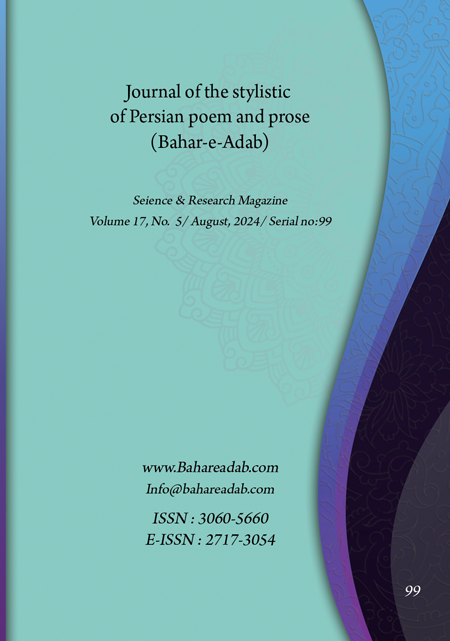- Count View : 157
- آدرس کوتاه شده مقاله: https://bahareadab.com/article_id/1721
- کد doi مقاله: Doi: 10.22034/bahareadab.2024 .17 .7447
Journal of the stylistic of Persian poem and prose
volume Number 17،
number In Volume 5،
،
issue Number 99
Stylistics of Masnavi "Fihrest Jahan" from "Mokhayyereh- Mohayyreh" by Ala’eddin Kermani (poet of the 9th century of Hijri)
Monavvar Jan , Abdul Reza Seif (Author in Charge), Mahmoud Fazilah
Abstract
BACKGROUND AND OBJECTIVES: Khumsa "Makhira" or "Muhirah" was written in imitation of Khumsa Nizami (the founder of Khumsa Sarai in Persian literature) and by a poet named Abdul Wahab bin Muhammad Mahmoud bin Muhammad Omar Kermani in the 9th century AH. (15 AD). In Türkiye, it is kept in the libraries of Istanbul University and Hagia Sophia Library. This essay is the result of the bibliographic and stylistic analysis of the second volume of this Khamsa titled "The World List".
METHODOLOGY: The current research is a theoretical study that was conducted using a library method and a descriptive-analytical method, and its sources are based on the version of the Istanbul Library (913 AH).
FINDINGS: The findings of the research show that this poem was written following the military poetry of Khosrow and Shirin. Despite this, except for the weight, it has no resemblance or proportion. The poet believes that the legend of Khosrow and Shirin has nothing new to say and a new plan should be thought of. Aladdin has created original and sometimes beautiful and pleasant ballads following Nizami, and this can be seen as one of the advantages of his style. The content of this work is educational and in the field of philosophy and mysticism.
CONCLUSION: The poems are simple and fluent in terms of language. But the number of Arabic words in it is very high. The number of verses in this masnavi is not significant. Despite this, he has used a variety of rows. In terms of rhyme, "verb" and "noun" respectively constitute the most types of words in rhyme. Puns are widely used among innovative industries. In terms of rhetoric, it has various rhetorical techniques and industries; And sometimes it contains strong and creative similes. Among the types of similes, eloquent similes and then detailed similes are the most frequent. After simile, metaphor is the most frequent among expressive arts. The frequency of metaphor in the play is more than that of Makaniyyah. The poet has made the most of current references. The content of the work is educational and mystical, and during these discussions, he praises the Prophet, describes nature, flocks and herds from the past, etc., and in general, it can be said that he is more skilled in expressing lyrical themes than educational ones. themes
Keyword
Aladdin Kermani
, Khamsa Mokhira or Mohira
, Nizami
, Masnavi
, stylistics
- -Qurān
- -Azimi, Habibullah (2010), The Principles and Basics of Manuscripts in Manuscripts, Tehran: Organization of Documents and National Library.
- -Dahmardeh, H. (2013). A Flame of Nezami’s Language. Literary Arts, 5(1), 81-96.
- Fotouhi Roud Mojani,M.(2011).Stylistics, Theories, Approaches & Methods, Tehran: sokhan.
- Homaei, j.(1984). Technics of Rhetoric literary industries.Tehran: Toos.
- -Hāfez Shirazi, Sh. M. (2011), Divan, Tehrān: shaghayegh.
- -Manuscript of "Khamseh Mokhira or Mohira", Hagia Sophia library, with registration number 3855.
- -Manuscript of "Khamse Mokhireh or Mohireh", Istanbul University Library, with registration number 1398.
- -Mallah,H (2015) The link between music and poetry, Tehran,Faza
- -MOHAMMADI H, arabi S, Torabi Farsani S. (2019) Political and intellectual discourse of Tariqat Naqshbandiyah during the Timurid era, 11 (41), 155-179.
- -Öner, Harun, (2021) KEVKEBÎ'S MESNAVI CALLED ÂYÎNE-İ DİL, Istanbul
- -Ripka, Yan et al. (1991) History of Iranian literature, translated by Keykhosrow, Tehran: Gutenberg and Javidan Khard.
- -Sadeghi, Ali Ashraf (2015) Persian Comprehensive Language, Volume 2, Tehran: Persian Language and Literature Academy.
- -Vaezzadeh, A., Ghavam, A., Radmard, A., & Salehinia, M. (2013). From Khamseh / Quintet Composing to Khamseh / ouintet Scholarships (critical Study of Khamseh / Quintet Researches). Journal of Persian Language & Literature (Former Journal of the Faculty of Literature, University of Tabriz), 65 (226), 129-163
- Shamisa,S.(2012).Meanings, Tehran: Mitra.
- Shamisa,S.(2013).Bayan, Tehran: Mitra.
- Shamisa,S.(2015).Literary Types, Tehran:Mitra.
- Shamisa,S.(2004). Literary Criticism,Tehran: Mitra.
- Shamisa,S.(1996). Stylistics of poem. Tehran: Mitra

